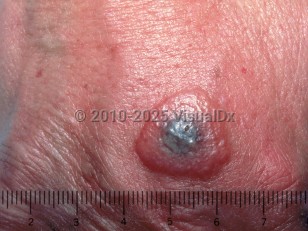Milker's nodules
Alerts and Notices
Important News & Links
Synopsis

Milker's nodules, also known as paravaccinia or pseudocowpox, is a cutaneous disease transmitted from dairy cows to humans. It is a self-limiting infection caused by a parapox virus. In humans, the virus causes lesions on areas of skin that are in direct contact with the cow, classically the hands, wrists, and arms.
The incubation period in humans ranges from 5-28 days, followed by the appearance of violaceous nodules that may be smooth, verrucous, or, less commonly, pustular or bullous. Lesions may be surmounted by a superficial grayish crust. Classically, 1-5 lesions are present on an affected individual, each roughly 0.6-2 cm. Mild constitutional symptoms such as low-grade fever, regional lymphadenitis, and moderate leukocytosis and eosinophilia may be present. The lesions of milker's nodules may be painful on direct pressure. Although rare, milker's nodules may be spread from person to person via direct contact. The condition usually resolves in about 6 weeks.
A detailed patient history will typically elicit exposure to a cow, usually through milking. The cow may actually have papular, pustular, vesicular, or crusted lesions upon the teats and possibly other areas. Lesions in cattle are often accompanied by alopecia. Epidemics affecting many animals within a herd are common. Infections in cows are thought to be spread by contact, either through milking machines or the farmers.
The incubation period in humans ranges from 5-28 days, followed by the appearance of violaceous nodules that may be smooth, verrucous, or, less commonly, pustular or bullous. Lesions may be surmounted by a superficial grayish crust. Classically, 1-5 lesions are present on an affected individual, each roughly 0.6-2 cm. Mild constitutional symptoms such as low-grade fever, regional lymphadenitis, and moderate leukocytosis and eosinophilia may be present. The lesions of milker's nodules may be painful on direct pressure. Although rare, milker's nodules may be spread from person to person via direct contact. The condition usually resolves in about 6 weeks.
A detailed patient history will typically elicit exposure to a cow, usually through milking. The cow may actually have papular, pustular, vesicular, or crusted lesions upon the teats and possibly other areas. Lesions in cattle are often accompanied by alopecia. Epidemics affecting many animals within a herd are common. Infections in cows are thought to be spread by contact, either through milking machines or the farmers.
Codes
ICD10CM:
B08.03 – Pseudocowpox [milker's node]
SNOMEDCT:
27240009 – Milker's nodule
B08.03 – Pseudocowpox [milker's node]
SNOMEDCT:
27240009 – Milker's nodule
Look For
Subscription Required
Diagnostic Pearls
Subscription Required
Differential Diagnosis & Pitfalls

To perform a comparison, select diagnoses from the classic differential
Subscription Required
Best Tests
Subscription Required
Management Pearls
Subscription Required
Therapy
Subscription Required
References
Subscription Required
Last Updated:09/25/2019
Milker's nodules

